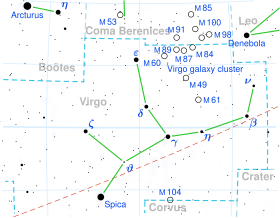九卿一
外观
(重定向自室女座ρ)
| 觀測資料 曆元 J2000.0 | |
|---|---|
| 星座 | 室女座 |
| 星官 | 九卿(太微垣) |
| 赤經 | 12h 41m 53.05658s[1] |
| 赤緯 | +10° 14′ 51.1699″[1] |
| 視星等(V) | +4.88[2] |
| 特性 | |
| 光谱分类 | A0 V[3] |
| U−B 色指数 | +0.03[4] |
| B−V 色指数 | +0.09[4] |
| 天体测定 | |
| 徑向速度 (Rv) | +1.6[2] km/s |
| 自行 (μ) | 赤经:+82.67[1] mas/yr 赤纬:–89.08[1] mas/yr |
| 视差 (π) | 27.57 ± 0.21[1] mas |
| 距离 | 118.3 ± 0.9 ly (36.3 ± 0.3 pc) |
| 绝对星等 (MV) | +1.90±0.28[5] |
| 詳細資料 | |
| 質量 | 2.0[6] M☉ |
| 半徑 | 1.6[6] R☉ |
| 表面重力 (log g) | 4.36[7] |
| 亮度 | 14[6] L☉ |
| 溫度 | 8,930[6] K |
| 金属量 [Fe/H] | –1.00[7] dex |
| 自轉速度 (v sin i) | 154[8] km/s |
| 其他命名 | |
| 參考資料庫 | |
| SIMBAD | 资料 |
九卿一(Rho Virginis、ρ Vir、ρ Virginis)是星座室女座中的一顆恆星,拜耳名稱為室女座ρ。它的視星等為 +4.9[2],這使得從都市地區用肉眼觀看是一個挑戰(根據波特爾暗空分類法)。到這顆恆星的距離是用視差方法直接量測的,這使其118.3光年(36.3秒差距)有大約一光年的誤差範圍[1]。
九卿一是一顆A型主序星,恆星分類為A0V[3]。它的半徑比太陽大60%[6],質量大約是太陽的兩倍。因此,它以比太陽更高的速度產生能量,光度超過太陽的14倍[6]。外層大氣的有效溫度為8,930 K[6],這就是它發出A型恆星白色光芒的原因。它被歸類為盾牌座δ型變星,亮度在0.5到2.4小時內變化0.02等。
這顆恆星已被確定為牧夫座λ型星,顯示出鐵峰元素的低豐度。它顯示出紅外發射過量,但尚不清楚這是由星周岩屑盤引起的,還是由恆星穿過並加熱擴散的星際塵埃雲引起的。很可能是前者[6],在這種情況下,塵埃盤的半徑約為37AU,平均溫度為90K[9]。
參考資料
[编辑]- ^ 1.0 1.1 1.2 1.3 1.4 1.5 van Leeuwen, F. Validation of the new Hipparcos reduction. Astronomy and Astrophysics. November 2007, 474 (2): 653–664. Bibcode:2007A&A...474..653V. S2CID 18759600. arXiv:0708.1752
 . doi:10.1051/0004-6361:20078357.
. doi:10.1051/0004-6361:20078357.
- ^ 2.0 2.1 2.2 Wielen, R.; et al, Sixth Catalogue of Fundamental Stars (FK6). Part I. Basic fundamental stars with direct solutions, Veroeffentlichungen des Astronomischen Rechen-Instituts Heidelberg (Astronomisches Rechen-Institut Heidelberg), 1999, 35 (35): 1, Bibcode:1999VeARI..35....1W.
- ^ 3.0 3.1 Cowley, A.; et al, A study of the bright A stars. I. A catalogue of spectral classifications, Astronomical Journal, April 1969, 74: 375–406, Bibcode:1969AJ.....74..375C, doi:10.1086/110819.
- ^ 4.0 4.1 Johnson, H. L.; et al, UBVRIJKL photometry of the bright stars, Communications of the Lunar and Planetary Laboratory, 1966, 4 (99): 99, Bibcode:1966CoLPL...4...99J.
- ^ Paunzen, E.; et al, The status of Galactic field λ Bootis stars in the post-Hipparcos era, Monthly Notices of the Royal Astronomical Society, November 2002, 336 (3): 1030–1042, Bibcode:2002MNRAS.336.1030P, S2CID 2389489, arXiv:astro-ph/0207488
 , doi:10.1046/j.1365-8711.2002.05865.x.
, doi:10.1046/j.1365-8711.2002.05865.x.
- ^ 6.0 6.1 6.2 6.3 6.4 6.5 6.6 6.7 Martínez-Galarza, J. R.; et al, Infrared Emission by Dust Around λ Bootis Stars: Debris Disks or Thermally Emitting Nebulae?, The Astrophysical Journal, March 2009, 694 (1): 165–173, Bibcode:2009ApJ...694..165M, S2CID 14298654, arXiv:0812.2198
 , doi:10.1088/0004-637X/694/1/165.
, doi:10.1088/0004-637X/694/1/165.
- ^ 7.0 7.1 Sturenburg, S., Abundance Analysis of Lambda-Bootis Stars, Astronomy and Astrophysics, September 1993, 277 (1): 139, Bibcode:1993A&A...277..139S.
- ^ Royer, F.; Zorec, J.; Gómez, A. E., Rotational velocities of A-type stars. III. Velocity distributions, Astronomy and Astrophysics, February 2007, 463 (2): 671–682, Bibcode:2007A&A...463..671R, S2CID 18475298, arXiv:astro-ph/0610785
 , doi:10.1051/0004-6361:20065224.
, doi:10.1051/0004-6361:20065224.
- ^ Zuckerman, B.; Song, Inseok, Dusty Debris Disks as Signposts of Planets: Implications for Spitzer Space Telescope, The Astrophysical Journal, March 2004, 603 (2): 738–743, Bibcode:2004ApJ...603..738Z, S2CID 3456817, arXiv:astro-ph/0311546
 , doi:10.1086/381700.
, doi:10.1086/381700.

